Howdy fellas, I thought I would share my research with you fellas, being I am a Cosmograph Idiot....here goes
The stainless steel Rolex Oyster Chronograph Ref. 6263, known to collectors as the "Daytona" which was produced from 1971 until 1987
stainless steel luminous markers, and screw-down stainless steel pushers. It comes on an original Rolex stainless steel Oyster bracelet.
(A must have for most Daytona guys) *see pics of MR's 6263 below
The story of the Rolex Oyster Cosmograph (with screw-down waterproof pushers) started in 1965 with the launch of ref. 6240. In 1971, the ref. 6263 (with acriclic bezel) and 6265 (with steel bezel) were introduced to replace the previous models: they had a larger winder, a solid bracelet and were both powered by Rolex cal. 727 (based on Valjoux 72).
6263 Cosmograph from 1974. The watch was special in the sense that the dial had white gold markers (hence the sigma-T-swiss-T-sigma at the bottom) and did not have the Daytona mention on it, like on ref. 6240.
The Rolex Chronograph Ref. 6238 "Pre-Daytona" Model

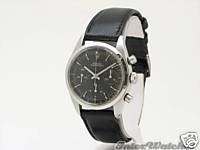
*smooth non Tach bezel
Produced in the begining of the 1960s to 1967, the chronograph ref. 6238 is one of the last models with "smooth bezel" and graduated scale printed on dial. A casual and sporty watch.
It's design more modern compared to earlier Rolex Chronograph watches. Considered the predecessor of the Daytona, the Reference 6238 is known among collectors as the Pre Daytona model.
The first series, introduced around the serial number 1000000, was realized with a Silver monochromatic dial (dark or light with radial shading) or black (more rare). The rarest model contains the medical scale.
Characteristics of the Rolex Chronograph Pre-Daytona Ref. 6238:
Case: Oyster with Push-down buttons, Oyster Twinlock 600 series winding crown, smooth metal bezel, domed plexiglas crystal, monochromatic dial and registers. The most characteristic feauture is the graduated scale printed on dial.
Dial: Rolex Chronograph inscription with unspecified waterproof depth.
Movement: valjoux caliber 72 B (until 1965) or caliber 722 (from. approx. 1965 to 1967).
The Rolex Oyster Cosmograph Daytona - Ref. 6263 and 6265
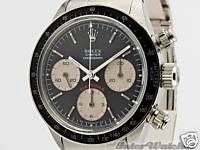
Notice the sec@9 markers are 20, 40 and 60...NON-NEWMAN Dial

*Pic borrowed from MR's site..ty littlepopeye
There are two series of the Rolex Cosmograph Daytona. The original series, produced in small quantities from the early 1960s to the later 1980s, has a four-digits mox del or reference number, for example the reference 6263. This original series eventually became iconic[vague] but in very short supply in the early 1990s, which led to a second series to meet demand. This second series was a Zenith modified movement, the five digit series movements noted by dropping the "1" from the current 6 digit code is notably the most accurate of all movements whose pedigree is in the famous Zenith "El Primero" movement. This movement was originally manufactured and released in the '60s and is still the highest VPH mass produced movement on the market at 36,000 VPH. The "El Primero" movement is often considered the hallmark of chronographs for accuracy and reliability.
Rolex purchased these movements for the Daytona and then modified the movement from 36,000VPH to 28,800VPH and made a few other subtle changes. These later series Daytonas prior to in-house movements were produced from 1988 to 2000 and represent the time period where Rolex Daytonas really began cult status, due to its limited production, accuracy, reliability and limited supply as they were coming from Zenith. This Zenith based movement is often considered more accurate and reliable than any other movement in the Chronograph space, including the current in-house Rolex Daytona model. The current series, the Rolex in-house made movement, has a six-digit reference number, for example reference 116520. The new six-digit Daytonas are certified, self-winding chronometers with chronograph functions. Rolex was, and remains today, a sponsor of the Rolex 24 at Daytona race at the time, and named its chronograph watch after that famous race.
Although Rolex continues to manufacture a version of the "Daytona", the rarest versions of the Rolex Daytona are the first versions, those whose reference number contains four digits, for example the 6238, 6239, 6240, 6241, 6262, 6263 6264 and 6265 References, produced from 1961 to 1987. The 6238, 6239, 6241 and 6262 References were the first versions, and were not "Oyster" versions, they did not have a screw down winding crown or screw down timing buttons. The movement used was a manual wind Valjoux cal. 72, named the Rolex Cal. 722. The 6263, 6264 and 6265 References were produced commencing 1970, were Oyster versions with screw down crown and screw down timing buttons. The movement used remained based on the manual wind Valjoux cal. 72, but with some refinements, and was called the Rolex Cal. 727. These Daytonas are very rare and very collectible. The movement has proven to be exceptionally reliable and accurate. In fact, the Cal. 727 was certified as a chronometer in some cases.
At the beginning of the 1970s, and until approximately the end of 1987, Rolex presents the two new chronograph references 6263 and 6265. In the continuous search to improve the waterproofing Rolex introduces various modifications differing from references 6262 and 6264, reintroducing the use of the screw-down push buttons and a large winding crown, as used on ref. 6240.
Also the Daytona Cosmograph references 6263 and 6265 differ from each other in the type of bezel: with black plastic insert and tachymeter printed in white for ref. 6263; in metal with engraved tachymeter for ref. 6265.
Characteristics of the Oyster Cosmograph Daytona watches:
Case: Oyster, screw-down push buttons, oyster Twinlock 700 series winding crown, calibrated metal bezel with black insert and tachymeter printed in white (ref. 6263), calibrated metal bezel (ref. 6265), domed plexiglass crystal (until approx. 1980). *The standard plexiglass crystal (from approx. 1980 to the end of production)
Dial: color contrast between dial and registers with ROLEX OYSTER COSMOGRAPH printing; DAYTONA in red above hour totalizer (only Stainless Steel models from the half of 1970s on) and also SUPERLATIVE CHRONOMETER OFFICIALLY CERTIFIED (only on gold models, not always present). Declared waterproofing of Cosmograph Daytona model is 50 meters (165 ft) approx. until the beginning of 1980s and 100 meters (330 ft) until the end of production.
The Paul Newman
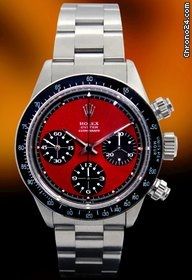
*Notice the subdials, the sec@9 has numbers at 15, 30, 45 and 60, and the CrossHair's
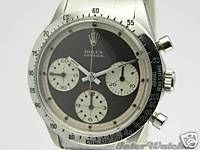
The rarest Daytonas are those with the so-called "Paul Newman" dial. Its distinguishing features are subtle and often unnoticeable to the untrained eye. First, a Paul Newman dial must be in a Reference 6239, 6241, 6262, 6263, 6264 or 6265 watch, installed by Rolex Geneva as original. All of these References had acrylic domed crystals. That aside, the sub-dials (the dials that are the opposite or contrasting color of the main dial) of a Paul Newman dial have block markers instead of lines, will have crosshairs across each sub-dial meeting at centre (unlike the normal Daytona), and the minutes sub-dial placed at 9:00 is marked at 15, 30, 45 and 60, whereas a normal Daytona dial is marked at 20, 40 and 60. The dial may or may not have the word "Daytona" written on the dial above the hour sub-dial located at 6:00. The dial came in four color and layout combinations, and was installed as an option by Rolex on the Daytona line of watches in the Reference 6239, 6241, 6262, 6263, 6264 or 6265 watches. The watch has been out of production since the early 1970s, and Rolex is not able to supply any replacement version of it.[1][2]
It is said that Paul Newman wore this watch until his death in 2008,[3] and had done so since 1972, the watch having been given to him by his wife, Joanne Woodward, when Newman took up automobile racing.
The original Daytona watches were not in demand when produced, and were inexpensive, but have gained rapid esteem among collectors, are known as the "Holy Grail" of collectible watches and fetch considerable prices at auction.
Rolex Daytona with Paul Newman Dial - Ref. 6239 - Collectible
The Paul Newman dial
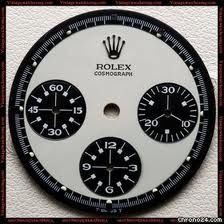
This version most tied to the car racing world, is born in collaboration with Rolex being the official chronometric time keeper of the racing circuit in Daytona, Florida, and Le Mans, France.
On the market after the Ref. 6239 came out in early 1960s and also referred to as “exotic†or “tropicalâ€, it is renamed as the Paul Newman by collectors, since it was worn by the actor to promote the film “Winning†on movie posters. In the movie the actor is seen wearing a Rolex watch, but not a chronograph Daytona with “exotic†dial. On more than one occasion however the actor can be seen wearing a Rolex with the dial to which he unknowingly lent his time.
Characterized by the 3D shape created by the levels between the central body of the dial, registers and chronographic seconds track, it is used on all the hand winding Daytona chronograph references, with the exception of gold models references 6269 and 6270.
The Daytona signature, present only on dials created for models with push-down buttons (refs. 6239, 6241, 6262, 6264) is always located above the hour totalizer: Printed in red on stainless steel models; printed in color contrasting to the background of the dial on Gold models. On dials meant for models with screw-down push buttons (refs. 6240, 6263, 6265) the Daytona signature is missing.
The three colors dial, only for stainless steel models, is available in two versions with ligth or black background, registers and chronographic seconds track in contrasting color and 60th scale in red. The Daytona signature is always printed in red above the hour totalizer.
Rolex Cosmograph Daytona Ref. 16500 series - Daytona Zenith

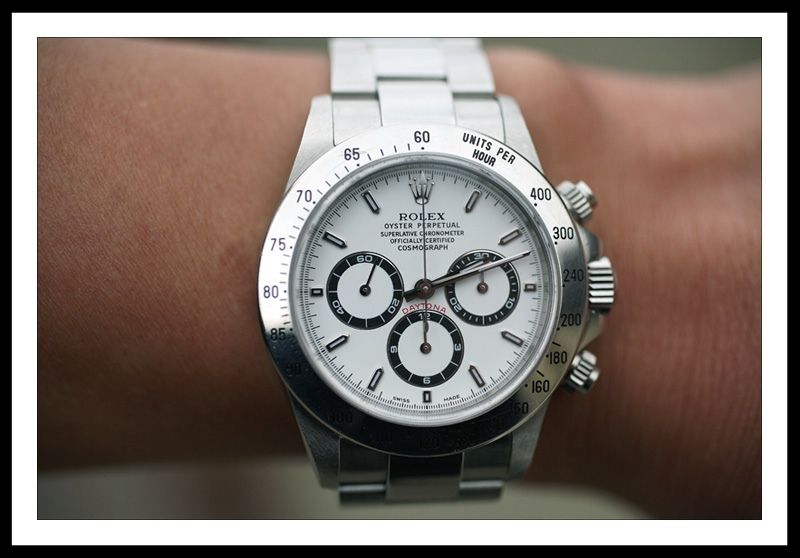
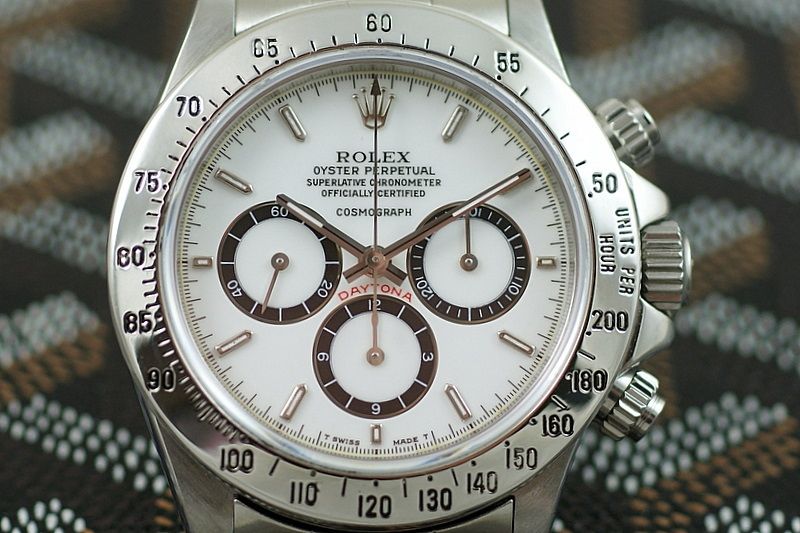
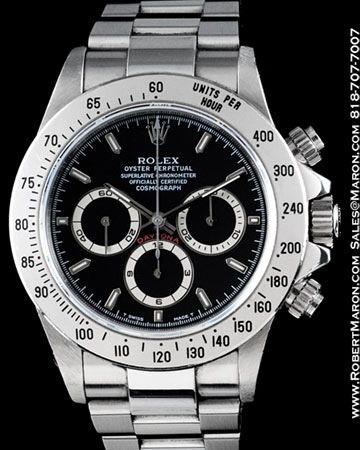
Year 1999 sec@9 Zenith Daytona.....(above)
My Trevor sec@9 Daytona........Trevor has these as of 4/29/12
This is basically a 116520 sec@6 Model with the subdials inverted to run @9, the natural design of the 7750.
The "tells" are,
Indice markers too fat, subdials are wrong spacing, surrounds are the wrong color..this IS NOT a replica of the El Primero Zenith...it is however a darn good replica because IT WORKS GREAT.....absolutely great.

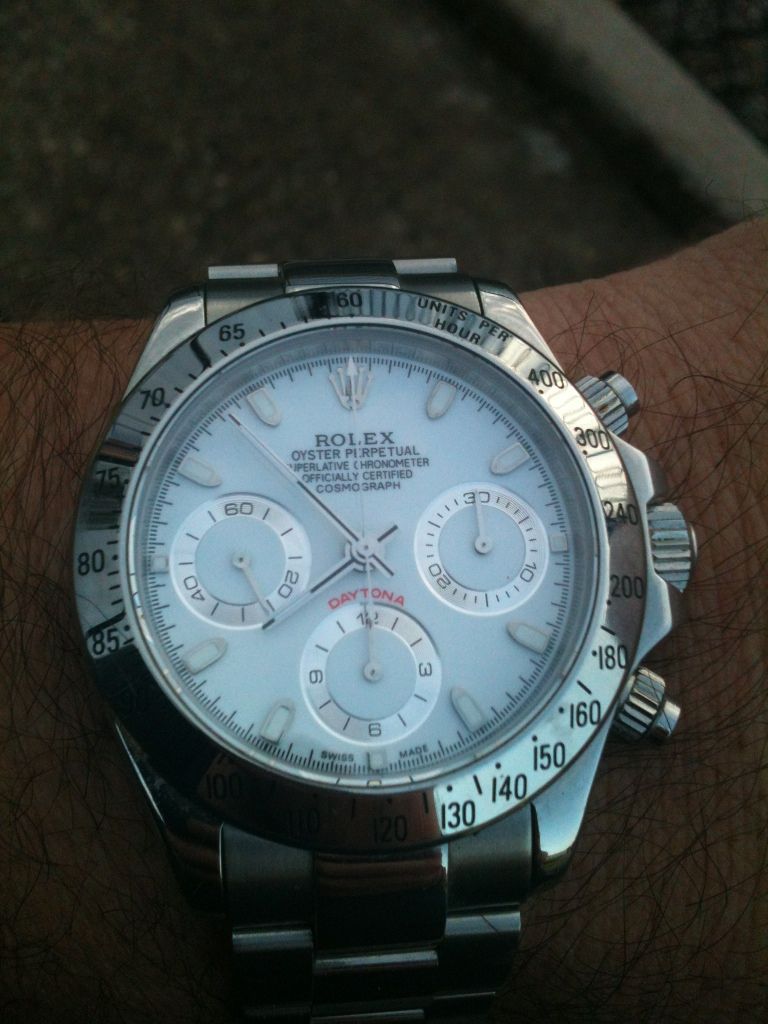
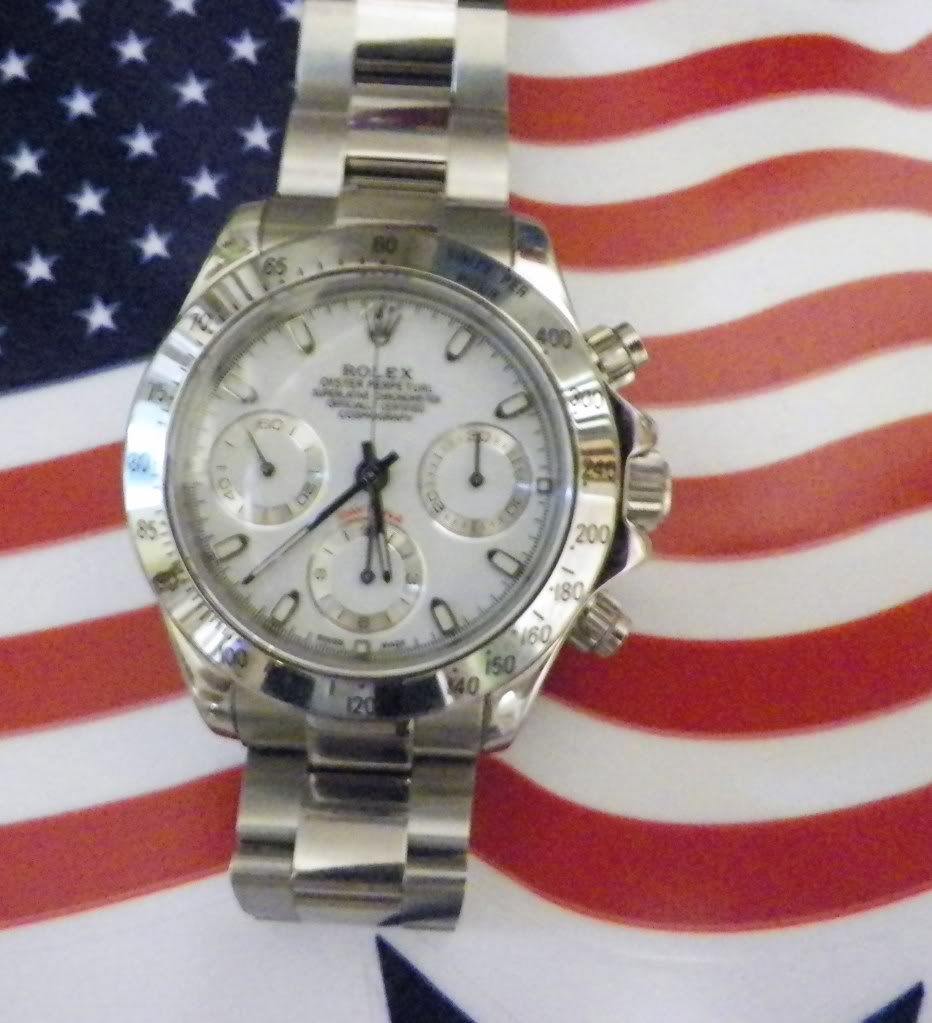
16520 & 116520 Quick Hits
Rolex Cosmograph Daytona Ref. 16500 series - Daytona Zenith
16520-Stainless Steel model,seconds @ 9, 2 dial colors white and black
production years*1988 to 2000
brushed lugs*
seconds subdial @ 9, 30min register@ 6 o'clock
<T swiss Made T> dial i.e. Tritium lume
wide indice markers
166520 *
production years 2000-present
*polished lugs
seconds @ 6
30min register @3 o'clock
Swiss Made dial, Lumiova lume
thinner indice markers
In 1988, Rolex started a modified Zenith movement, sometimes referred to a "The Zenith" Daytona....or better known WIS's as the El *Primero. *After stopping the production of hand winding Daytona chronographs, Rolex launches on the market its first automatic chronograph, waterproof up to 100 mts.
Also, due the limited numberof El Primero Daytona 16520's made, the price of one today is about the same as a 16520.
A YouTube Vid
http://www.youtube.com/watch?v=bkRSP...e_gdata_player
In 1988, after stopping the production of hand winding Daytona chronographs, Rolex launches on the market its first automatic chronograph, waterproof up to 100 mts.
Produced in stainless steel, steel & gold, and 18K gold, with metal bracelet and bezel, Rolex assigns a specific reference number to each model according to the material of construction: 16520 for the stainless steel model, 16523 for the steel & gold model and 16528 for the yellow gold model. After a few years Rolex added two new models to its series: in 1992 ref. 16518 in 18k Gold and leather strap; in 1997 Ref. 16519 in white gold and leather strap.
The most important change was the creation of the new movement caliber 4030, based on caliber 400 Zenith, the best industrial chronographic movement on the market at the time. Rolex performed about 200 modifications to reach their rigorous productive standards, such as the replacement of the reversing wheel and the elimination of the data indicator.
Rolex is thus able to re-launch the trend of chronographs: a new philosophy that will shortly make this watch a number one collector’s item.
Characteristics of the Cosmograph Daytona "Zenith" watches:
Case: Oyster, screw-down push buttons; Oyster Triplock 700 series winding crown, calibrated metal bezel, sapphire crystal. Dimensions: Cases's diameter = 40 mm; height= 12.6 mm.
Dial: color contrast between dial and registers track, dial indexes and registers track edge in metal, Printing on dial: ROLEX OYSTER PERPETUAL, certification of official chronometer (COSC), COSMOGRAPH DAYTONA in red above the hour totalizer and waterproof up to 100 mts (330 ft). Luminous material was tritium at first, Superluminova was used later.*
Movement: Rolex Caliber 4030 (base Caliber Zenith 400 El Primero), 31 jewels, 28800 beats per hour, 54-hour power reserve, Kif shock absorption; bi-directional rotor, fine regulation via Microstella screws; Breguet balance-spring; non-stop seconds function; official chronometer with C.O.S.C. certification.
** * Modern Daytona
Rolex Cosmograph Daytona Ref. 116500 series - Cosmograph Daytona 116520
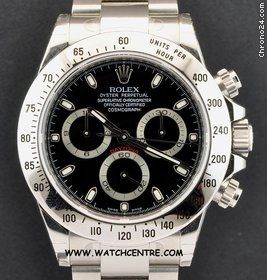
sec@6
In autumn of 1999 Rolex's technicians were already nearly finished with their work, not only with the construction of the firm's own caliber, but also with the years of testing that preceded its launch. The new Rolex Caliber 4130 debuted at the watch convention held in Basel, Switzerland in March of 2000. The Rolex Caliber 4030 Presents itself as a mature, uncommonly high-performance and unconditionally reliable chronograph movement.
This new Caliber construction results in a different Daytona model. The Hunter style construction (small seconds above the 6) rather than Léphine-style construction (with small seconds beside the 9). The result of this it's a new dial appearence with different chronograph register's position. The new Daytona dial also presents wide markers that makes it more readable.
With the Ref. 116500 Rolex includes the Stop-seconds function to the Cosmograph Daytona Chronograph that was not present in the old Cosmograph Daytona model.*
Characteristics of the New Cosmograph Daytona watches - Rolex Caliber 4130:
Case: Oyster, screw-down push buttons; screw down triplock crown with flank protection; screw-down push-pieces; fully threated; screw-down back; sapphire crystal; water resistant to 100 meters. Diameter: 40 mm; height: 12.4 mm (slightly thinner than the Old Daytona model):
Dial: Less color contrast between dial and registers track, wide dial indexes and registers track edge in metal, Printing on dial: ROLEX OYSTER PERPETUAL, certification of official chronometer (COSC).
Movement: Automatic chronograph movement; Rolex Caliber 4130; 44 jewels, 28800 beats per hour; 72-hour Power Reserve, Rolex own's spiral balance-spring; Kif shock absorption; bi-directional rotor; fine regulation with microstella screws, Breguet balance-spring, stop-seconds function, official chronometer with C.O.S.C. certification.
Hope this help make YOU...a Daytona man too....enjoy
The stainless steel Rolex Oyster Chronograph Ref. 6263, known to collectors as the "Daytona" which was produced from 1971 until 1987
stainless steel luminous markers, and screw-down stainless steel pushers. It comes on an original Rolex stainless steel Oyster bracelet.
(A must have for most Daytona guys) *see pics of MR's 6263 below
The story of the Rolex Oyster Cosmograph (with screw-down waterproof pushers) started in 1965 with the launch of ref. 6240. In 1971, the ref. 6263 (with acriclic bezel) and 6265 (with steel bezel) were introduced to replace the previous models: they had a larger winder, a solid bracelet and were both powered by Rolex cal. 727 (based on Valjoux 72).
6263 Cosmograph from 1974. The watch was special in the sense that the dial had white gold markers (hence the sigma-T-swiss-T-sigma at the bottom) and did not have the Daytona mention on it, like on ref. 6240.
The Rolex Chronograph Ref. 6238 "Pre-Daytona" Model


*smooth non Tach bezel
Produced in the begining of the 1960s to 1967, the chronograph ref. 6238 is one of the last models with "smooth bezel" and graduated scale printed on dial. A casual and sporty watch.
It's design more modern compared to earlier Rolex Chronograph watches. Considered the predecessor of the Daytona, the Reference 6238 is known among collectors as the Pre Daytona model.
The first series, introduced around the serial number 1000000, was realized with a Silver monochromatic dial (dark or light with radial shading) or black (more rare). The rarest model contains the medical scale.
Characteristics of the Rolex Chronograph Pre-Daytona Ref. 6238:
Case: Oyster with Push-down buttons, Oyster Twinlock 600 series winding crown, smooth metal bezel, domed plexiglas crystal, monochromatic dial and registers. The most characteristic feauture is the graduated scale printed on dial.
Dial: Rolex Chronograph inscription with unspecified waterproof depth.
Movement: valjoux caliber 72 B (until 1965) or caliber 722 (from. approx. 1965 to 1967).
The Rolex Oyster Cosmograph Daytona - Ref. 6263 and 6265

Notice the sec@9 markers are 20, 40 and 60...NON-NEWMAN Dial

*Pic borrowed from MR's site..ty littlepopeye
There are two series of the Rolex Cosmograph Daytona. The original series, produced in small quantities from the early 1960s to the later 1980s, has a four-digits mox del or reference number, for example the reference 6263. This original series eventually became iconic[vague] but in very short supply in the early 1990s, which led to a second series to meet demand. This second series was a Zenith modified movement, the five digit series movements noted by dropping the "1" from the current 6 digit code is notably the most accurate of all movements whose pedigree is in the famous Zenith "El Primero" movement. This movement was originally manufactured and released in the '60s and is still the highest VPH mass produced movement on the market at 36,000 VPH. The "El Primero" movement is often considered the hallmark of chronographs for accuracy and reliability.
Rolex purchased these movements for the Daytona and then modified the movement from 36,000VPH to 28,800VPH and made a few other subtle changes. These later series Daytonas prior to in-house movements were produced from 1988 to 2000 and represent the time period where Rolex Daytonas really began cult status, due to its limited production, accuracy, reliability and limited supply as they were coming from Zenith. This Zenith based movement is often considered more accurate and reliable than any other movement in the Chronograph space, including the current in-house Rolex Daytona model. The current series, the Rolex in-house made movement, has a six-digit reference number, for example reference 116520. The new six-digit Daytonas are certified, self-winding chronometers with chronograph functions. Rolex was, and remains today, a sponsor of the Rolex 24 at Daytona race at the time, and named its chronograph watch after that famous race.
Although Rolex continues to manufacture a version of the "Daytona", the rarest versions of the Rolex Daytona are the first versions, those whose reference number contains four digits, for example the 6238, 6239, 6240, 6241, 6262, 6263 6264 and 6265 References, produced from 1961 to 1987. The 6238, 6239, 6241 and 6262 References were the first versions, and were not "Oyster" versions, they did not have a screw down winding crown or screw down timing buttons. The movement used was a manual wind Valjoux cal. 72, named the Rolex Cal. 722. The 6263, 6264 and 6265 References were produced commencing 1970, were Oyster versions with screw down crown and screw down timing buttons. The movement used remained based on the manual wind Valjoux cal. 72, but with some refinements, and was called the Rolex Cal. 727. These Daytonas are very rare and very collectible. The movement has proven to be exceptionally reliable and accurate. In fact, the Cal. 727 was certified as a chronometer in some cases.
At the beginning of the 1970s, and until approximately the end of 1987, Rolex presents the two new chronograph references 6263 and 6265. In the continuous search to improve the waterproofing Rolex introduces various modifications differing from references 6262 and 6264, reintroducing the use of the screw-down push buttons and a large winding crown, as used on ref. 6240.
Also the Daytona Cosmograph references 6263 and 6265 differ from each other in the type of bezel: with black plastic insert and tachymeter printed in white for ref. 6263; in metal with engraved tachymeter for ref. 6265.
Characteristics of the Oyster Cosmograph Daytona watches:
Case: Oyster, screw-down push buttons, oyster Twinlock 700 series winding crown, calibrated metal bezel with black insert and tachymeter printed in white (ref. 6263), calibrated metal bezel (ref. 6265), domed plexiglass crystal (until approx. 1980). *The standard plexiglass crystal (from approx. 1980 to the end of production)
Dial: color contrast between dial and registers with ROLEX OYSTER COSMOGRAPH printing; DAYTONA in red above hour totalizer (only Stainless Steel models from the half of 1970s on) and also SUPERLATIVE CHRONOMETER OFFICIALLY CERTIFIED (only on gold models, not always present). Declared waterproofing of Cosmograph Daytona model is 50 meters (165 ft) approx. until the beginning of 1980s and 100 meters (330 ft) until the end of production.
The Paul Newman

*Notice the subdials, the sec@9 has numbers at 15, 30, 45 and 60, and the CrossHair's

The rarest Daytonas are those with the so-called "Paul Newman" dial. Its distinguishing features are subtle and often unnoticeable to the untrained eye. First, a Paul Newman dial must be in a Reference 6239, 6241, 6262, 6263, 6264 or 6265 watch, installed by Rolex Geneva as original. All of these References had acrylic domed crystals. That aside, the sub-dials (the dials that are the opposite or contrasting color of the main dial) of a Paul Newman dial have block markers instead of lines, will have crosshairs across each sub-dial meeting at centre (unlike the normal Daytona), and the minutes sub-dial placed at 9:00 is marked at 15, 30, 45 and 60, whereas a normal Daytona dial is marked at 20, 40 and 60. The dial may or may not have the word "Daytona" written on the dial above the hour sub-dial located at 6:00. The dial came in four color and layout combinations, and was installed as an option by Rolex on the Daytona line of watches in the Reference 6239, 6241, 6262, 6263, 6264 or 6265 watches. The watch has been out of production since the early 1970s, and Rolex is not able to supply any replacement version of it.[1][2]
It is said that Paul Newman wore this watch until his death in 2008,[3] and had done so since 1972, the watch having been given to him by his wife, Joanne Woodward, when Newman took up automobile racing.
The original Daytona watches were not in demand when produced, and were inexpensive, but have gained rapid esteem among collectors, are known as the "Holy Grail" of collectible watches and fetch considerable prices at auction.
Rolex Daytona with Paul Newman Dial - Ref. 6239 - Collectible
The Paul Newman dial

This version most tied to the car racing world, is born in collaboration with Rolex being the official chronometric time keeper of the racing circuit in Daytona, Florida, and Le Mans, France.
On the market after the Ref. 6239 came out in early 1960s and also referred to as “exotic†or “tropicalâ€, it is renamed as the Paul Newman by collectors, since it was worn by the actor to promote the film “Winning†on movie posters. In the movie the actor is seen wearing a Rolex watch, but not a chronograph Daytona with “exotic†dial. On more than one occasion however the actor can be seen wearing a Rolex with the dial to which he unknowingly lent his time.
Characterized by the 3D shape created by the levels between the central body of the dial, registers and chronographic seconds track, it is used on all the hand winding Daytona chronograph references, with the exception of gold models references 6269 and 6270.
The Daytona signature, present only on dials created for models with push-down buttons (refs. 6239, 6241, 6262, 6264) is always located above the hour totalizer: Printed in red on stainless steel models; printed in color contrasting to the background of the dial on Gold models. On dials meant for models with screw-down push buttons (refs. 6240, 6263, 6265) the Daytona signature is missing.
The three colors dial, only for stainless steel models, is available in two versions with ligth or black background, registers and chronographic seconds track in contrasting color and 60th scale in red. The Daytona signature is always printed in red above the hour totalizer.
Rolex Cosmograph Daytona Ref. 16500 series - Daytona Zenith




Year 1999 sec@9 Zenith Daytona.....(above)
My Trevor sec@9 Daytona........Trevor has these as of 4/29/12
This is basically a 116520 sec@6 Model with the subdials inverted to run @9, the natural design of the 7750.
The "tells" are,
Indice markers too fat, subdials are wrong spacing, surrounds are the wrong color..this IS NOT a replica of the El Primero Zenith...it is however a darn good replica because IT WORKS GREAT.....absolutely great.



16520 & 116520 Quick Hits
Rolex Cosmograph Daytona Ref. 16500 series - Daytona Zenith
16520-Stainless Steel model,seconds @ 9, 2 dial colors white and black
production years*1988 to 2000
brushed lugs*
seconds subdial @ 9, 30min register@ 6 o'clock
<T swiss Made T> dial i.e. Tritium lume
wide indice markers
166520 *
production years 2000-present
*polished lugs
seconds @ 6
30min register @3 o'clock
Swiss Made dial, Lumiova lume
thinner indice markers
In 1988, Rolex started a modified Zenith movement, sometimes referred to a "The Zenith" Daytona....or better known WIS's as the El *Primero. *After stopping the production of hand winding Daytona chronographs, Rolex launches on the market its first automatic chronograph, waterproof up to 100 mts.
Also, due the limited numberof El Primero Daytona 16520's made, the price of one today is about the same as a 16520.
A YouTube Vid
http://www.youtube.com/watch?v=bkRSP...e_gdata_player
In 1988, after stopping the production of hand winding Daytona chronographs, Rolex launches on the market its first automatic chronograph, waterproof up to 100 mts.
Produced in stainless steel, steel & gold, and 18K gold, with metal bracelet and bezel, Rolex assigns a specific reference number to each model according to the material of construction: 16520 for the stainless steel model, 16523 for the steel & gold model and 16528 for the yellow gold model. After a few years Rolex added two new models to its series: in 1992 ref. 16518 in 18k Gold and leather strap; in 1997 Ref. 16519 in white gold and leather strap.
The most important change was the creation of the new movement caliber 4030, based on caliber 400 Zenith, the best industrial chronographic movement on the market at the time. Rolex performed about 200 modifications to reach their rigorous productive standards, such as the replacement of the reversing wheel and the elimination of the data indicator.
Rolex is thus able to re-launch the trend of chronographs: a new philosophy that will shortly make this watch a number one collector’s item.
Characteristics of the Cosmograph Daytona "Zenith" watches:
Case: Oyster, screw-down push buttons; Oyster Triplock 700 series winding crown, calibrated metal bezel, sapphire crystal. Dimensions: Cases's diameter = 40 mm; height= 12.6 mm.
Dial: color contrast between dial and registers track, dial indexes and registers track edge in metal, Printing on dial: ROLEX OYSTER PERPETUAL, certification of official chronometer (COSC), COSMOGRAPH DAYTONA in red above the hour totalizer and waterproof up to 100 mts (330 ft). Luminous material was tritium at first, Superluminova was used later.*
Movement: Rolex Caliber 4030 (base Caliber Zenith 400 El Primero), 31 jewels, 28800 beats per hour, 54-hour power reserve, Kif shock absorption; bi-directional rotor, fine regulation via Microstella screws; Breguet balance-spring; non-stop seconds function; official chronometer with C.O.S.C. certification.
** * Modern Daytona
Rolex Cosmograph Daytona Ref. 116500 series - Cosmograph Daytona 116520

sec@6
In autumn of 1999 Rolex's technicians were already nearly finished with their work, not only with the construction of the firm's own caliber, but also with the years of testing that preceded its launch. The new Rolex Caliber 4130 debuted at the watch convention held in Basel, Switzerland in March of 2000. The Rolex Caliber 4030 Presents itself as a mature, uncommonly high-performance and unconditionally reliable chronograph movement.
This new Caliber construction results in a different Daytona model. The Hunter style construction (small seconds above the 6) rather than Léphine-style construction (with small seconds beside the 9). The result of this it's a new dial appearence with different chronograph register's position. The new Daytona dial also presents wide markers that makes it more readable.
With the Ref. 116500 Rolex includes the Stop-seconds function to the Cosmograph Daytona Chronograph that was not present in the old Cosmograph Daytona model.*
Characteristics of the New Cosmograph Daytona watches - Rolex Caliber 4130:
Case: Oyster, screw-down push buttons; screw down triplock crown with flank protection; screw-down push-pieces; fully threated; screw-down back; sapphire crystal; water resistant to 100 meters. Diameter: 40 mm; height: 12.4 mm (slightly thinner than the Old Daytona model):
Dial: Less color contrast between dial and registers track, wide dial indexes and registers track edge in metal, Printing on dial: ROLEX OYSTER PERPETUAL, certification of official chronometer (COSC).
Movement: Automatic chronograph movement; Rolex Caliber 4130; 44 jewels, 28800 beats per hour; 72-hour Power Reserve, Rolex own's spiral balance-spring; Kif shock absorption; bi-directional rotor; fine regulation with microstella screws, Breguet balance-spring, stop-seconds function, official chronometer with C.O.S.C. certification.
Hope this help make YOU...a Daytona man too....enjoy
